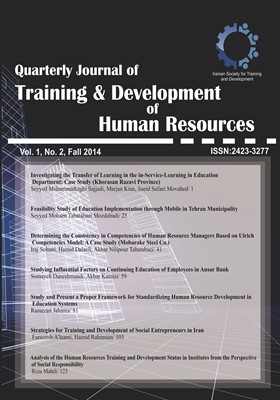-
-
List of Articles
-
Open Access Article
1 - Investigating the Transfer of Learning in the in-Service- Learning in Education Department: Case Study (Khorasan Razavi Province)
سید محمدتقی سجادی -
Open Access Article
2 - Investigating the Transfer of Learning in the in-Service- Learning in Education Department: Case Study (Khorasan Razavi Province)
سید محمدتقی سجادی -
Open Access Article
3 - آسیبشناسی پدیده انتقال آموزش در آموزشهای ضمنخدمت سازمان آموزش و پرورش (مطالعه موردی استان خراسان رضوی)
سید محمدتقی سجادی مرجان کیان -
Open Access Article
4 - Feasibility Study of Education Implementation through Mobile in Tehran Municipality
Seyed Mohsen Tabatabaei Mozdabadi -
Open Access Article
5 - Determining the Consistency in Competencies of Human Resource Managers Based on Ulrich Competencies Model: A Case Study (Mobarake Steel Co.)
iraj soltani -
Open Access Article
6 - Studying Influential Factors on Continuing Education of Employees in Ansar Bank
-
Open Access Article
7 - Study and Present a Proper Framework for Standardizing Human Resource Development in Education Systems
رمضان جهانیان -
Open Access Article
8 - Strategies for Training and Development of Social Entrepreneurs in Iran
farnosh allami hamid rahimian -
Open Access Article
9 - Analysis of the Human Resources Training and Development Status in Institutes from the Perspective of Social Responsibility
-
The rights to this website are owned by the Raimag Press Management System.
Copyright © 2017-2025







